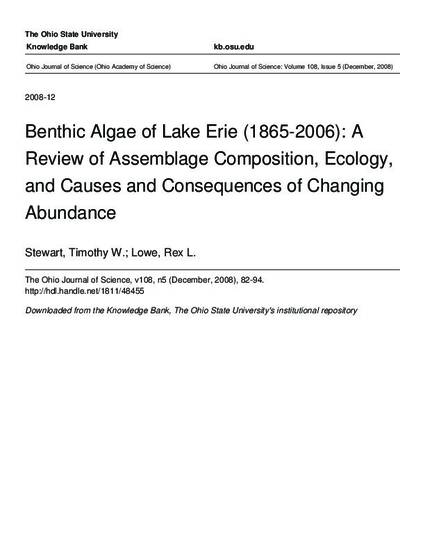
Peer-reviewed literature and published reports were used to summarize knowledge of benthic algal assemblage composition and ecology in Lake Erie, and causes and consequences of temporal variation in algal abundance. Macroalgal assemblages in rocky littoral and soft substrate habitats have been reasonably well described and studied, as has the epiphyte/metaphyte assemblage associated with rocky littoral macroalgae. In contrast, little information exists for non-epiphytic microalgae in littoral habitat. During the period when algal records were reported (1865-2006), the rocky littoral macroalgal assemblage was often dominated by the chlorophyte genera Cladophora and Ulothrix and the rhodophyte Bangia, whereas the charophytes Chara and Nitella were most abundant in littoral soft substrate. In addition to substrate effects, assemblage composition varied as a function of depth, temperature, light levels, and nutrient concentrations. Under certain conditions, macroalgal taxa appeared to outcompete and exclude other taxa from littoral habitat. However, these organisms have also facilitated increased algal diversity by supporting epiphytes/metaphytes. In Lake Erie, significant temporal change in benthic algal abundance has been associated with: 1) eutrophication (prior to 1972), 2) oligotrophication following the Great Lakes Water Quality Agreement (1972-1985), and 3) invasion by Dreissena mussels (1986-2006). Increasingly eutrophic conditions were reflected by high abundance and frequent shoreline fouling by Cladophora, declining charophyte (such as Chara, Nitella) abundance, and invasion of rocky littoral habitat by euryhaline Bangia. Subsequent indicators of oligotrophication included declining Cladophora abundance, and increased diatom abundance in deepwater habitat. Effects of filter-feeding Dreissena (such as increased water clarity, phosphorus excretion) were likely causes for Cladophora resurgence in the 1990s, and likely contributed to return of Chara and Nitella to formerly occupied habitat. Algal assemblages clearly reflect environmental conditions in aquatic ecosystems. To accurately assess present and future conditions in Lake Erie, continued study of all benthic assemblages is recommended, with greater attention directed toward microalgae in littoral habitat than has occurred in the past.
Available at: http://works.bepress.com/timothy_stewart/8/

This article is from Ohio Journal of Science 108 (2008): 82. Posted with permission.